Tax Evasion and Avoidance in UK
VerifiedAdded on 2019/12/03
|32
|10303
|285
Report
AI Summary
This report delves into the complex issues of tax evasion and avoidance, particularly within the context of the United Kingdom. It explores the legal and illegal aspects of these practices, examining how multinational corporations and wealthy individuals utilize loopholes and tax havens to minimize their tax liabilities. The report analyzes the differences between tax evasion and tax avoidance, the methods employed for profit shifting, and the role of tax havens in facilitating these activities. It also investigates the impact of these practices on government revenue and the inconsistencies between UK and EU tax laws. The research methodology employed is qualitative, relying on secondary data analysis to provide a comprehensive understanding of the topic. The report concludes by highlighting the thin line between legal tax avoidance and illegal tax evasion, emphasizing the need for further research and policy changes to address these issues.
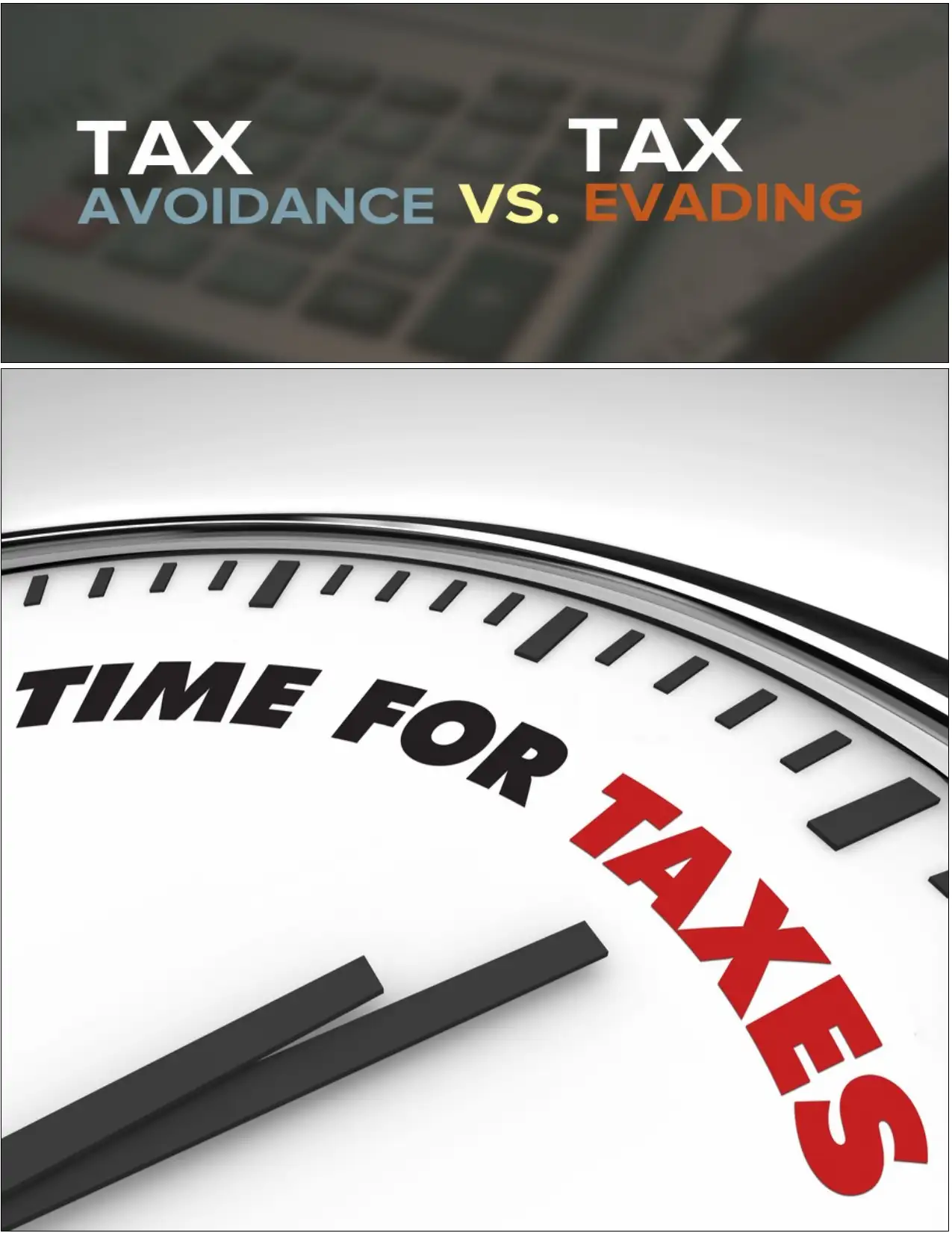
Paraphrase This Document
Need a fresh take? Get an instant paraphrase of this document with our AI Paraphraser

ACKNOWLEDGEMENT

ABSTRACT
⊘ This is a preview!⊘
Do you want full access?
Subscribe today to unlock all pages.

Trusted by 1+ million students worldwide
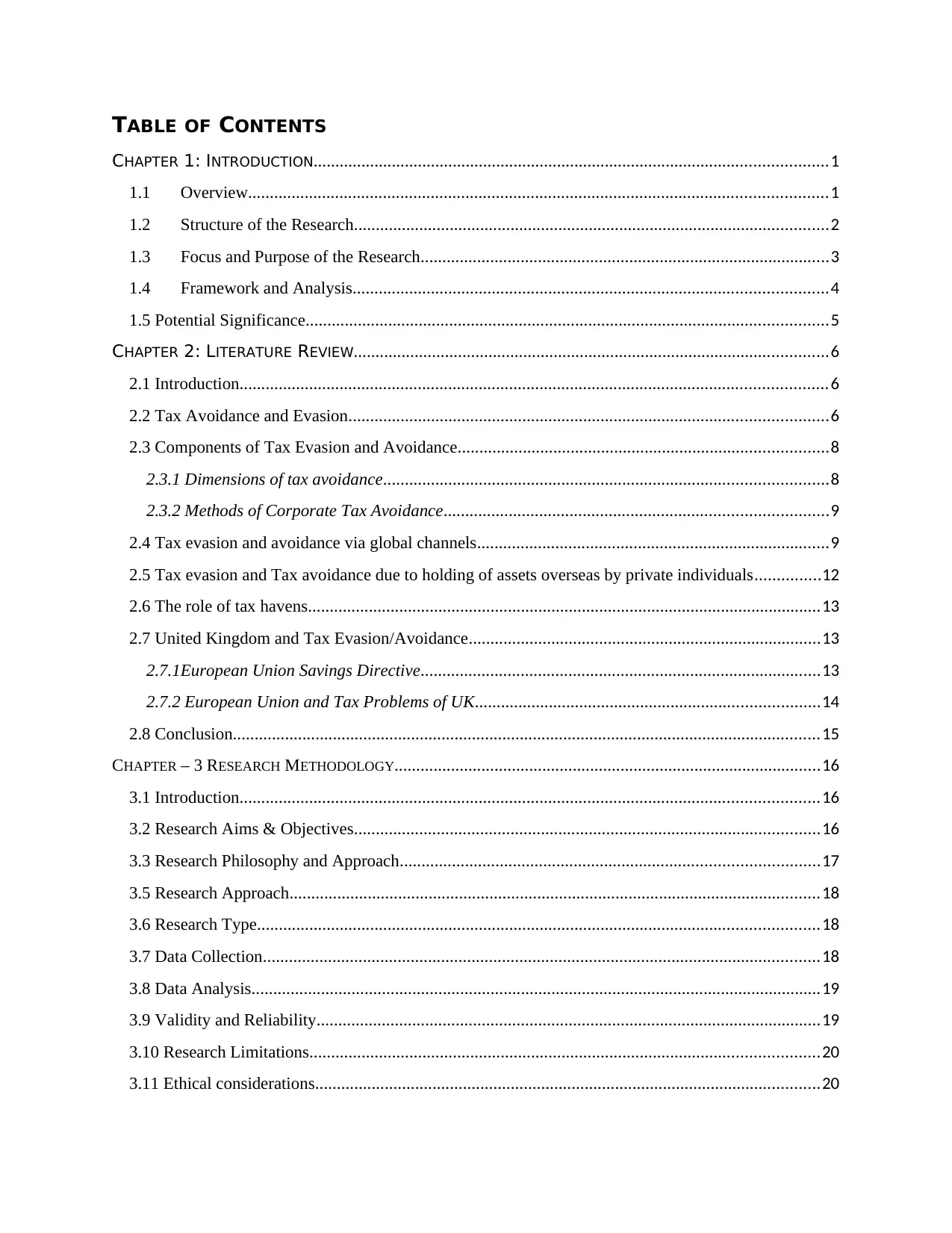
TABLE OF CONTENTS
CHAPTER 1: INTRODUCTION......................................................................................................................1
1.1 Overview.....................................................................................................................................1
1.2 Structure of the Research.............................................................................................................2
1.3 Focus and Purpose of the Research..............................................................................................3
1.4 Framework and Analysis.............................................................................................................4
1.5 Potential Significance........................................................................................................................5
CHAPTER 2: LITERATURE REVIEW.............................................................................................................6
2.1 Introduction.......................................................................................................................................6
2.2 Tax Avoidance and Evasion..............................................................................................................6
2.3 Components of Tax Evasion and Avoidance.....................................................................................8
2.3.1 Dimensions of tax avoidance......................................................................................................8
2.3.2 Methods of Corporate Tax Avoidance........................................................................................9
2.4 Tax evasion and avoidance via global channels.................................................................................9
2.5 Tax evasion and Tax avoidance due to holding of assets overseas by private individuals...............12
2.6 The role of tax havens......................................................................................................................13
2.7 United Kingdom and Tax Evasion/Avoidance.................................................................................13
2.7.1European Union Savings Directive............................................................................................13
2.7.2 European Union and Tax Problems of UK...............................................................................14
2.8 Conclusion.......................................................................................................................................15
CHAPTER – 3 RESEARCH METHODOLOGY..................................................................................................16
3.1 Introduction.....................................................................................................................................16
3.2 Research Aims & Objectives...........................................................................................................16
3.3 Research Philosophy and Approach................................................................................................17
3.5 Research Approach..........................................................................................................................18
3.6 Research Type.................................................................................................................................18
3.7 Data Collection................................................................................................................................18
3.8 Data Analysis...................................................................................................................................19
3.9 Validity and Reliability....................................................................................................................19
3.10 Research Limitations.....................................................................................................................20
3.11 Ethical considerations....................................................................................................................20
CHAPTER 1: INTRODUCTION......................................................................................................................1
1.1 Overview.....................................................................................................................................1
1.2 Structure of the Research.............................................................................................................2
1.3 Focus and Purpose of the Research..............................................................................................3
1.4 Framework and Analysis.............................................................................................................4
1.5 Potential Significance........................................................................................................................5
CHAPTER 2: LITERATURE REVIEW.............................................................................................................6
2.1 Introduction.......................................................................................................................................6
2.2 Tax Avoidance and Evasion..............................................................................................................6
2.3 Components of Tax Evasion and Avoidance.....................................................................................8
2.3.1 Dimensions of tax avoidance......................................................................................................8
2.3.2 Methods of Corporate Tax Avoidance........................................................................................9
2.4 Tax evasion and avoidance via global channels.................................................................................9
2.5 Tax evasion and Tax avoidance due to holding of assets overseas by private individuals...............12
2.6 The role of tax havens......................................................................................................................13
2.7 United Kingdom and Tax Evasion/Avoidance.................................................................................13
2.7.1European Union Savings Directive............................................................................................13
2.7.2 European Union and Tax Problems of UK...............................................................................14
2.8 Conclusion.......................................................................................................................................15
CHAPTER – 3 RESEARCH METHODOLOGY..................................................................................................16
3.1 Introduction.....................................................................................................................................16
3.2 Research Aims & Objectives...........................................................................................................16
3.3 Research Philosophy and Approach................................................................................................17
3.5 Research Approach..........................................................................................................................18
3.6 Research Type.................................................................................................................................18
3.7 Data Collection................................................................................................................................18
3.8 Data Analysis...................................................................................................................................19
3.9 Validity and Reliability....................................................................................................................19
3.10 Research Limitations.....................................................................................................................20
3.11 Ethical considerations....................................................................................................................20
Paraphrase This Document
Need a fresh take? Get an instant paraphrase of this document with our AI Paraphraser

All the information that has been collected has not been manipulated and present in its actual form....20
CHAPTER – 4 DATA ANALYSIS AND FINDINGS..........................................................................................21
CHAPTER – 5 CONCLUSION AND RECOMMENDATIONS..............................................................................22
CHAPTER – 6 REFLECTIVE STATEMENT.....................................................................................................23
REFERENCES..............................................................................................................................................24
CHAPTER – 4 DATA ANALYSIS AND FINDINGS..........................................................................................21
CHAPTER – 5 CONCLUSION AND RECOMMENDATIONS..............................................................................22
CHAPTER – 6 REFLECTIVE STATEMENT.....................................................................................................23
REFERENCES..............................................................................................................................................24
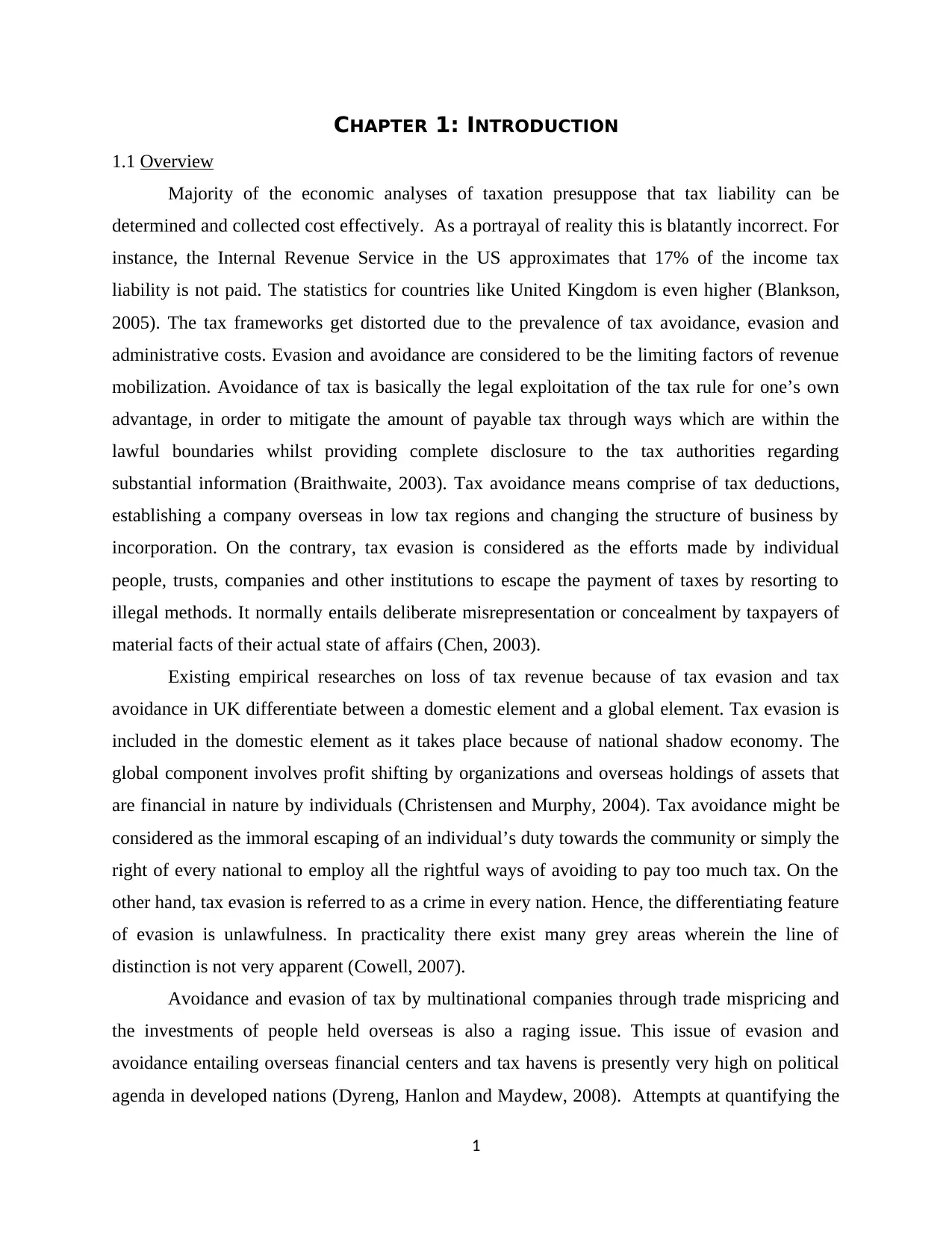
CHAPTER 1: INTRODUCTION
1.1 Overview
Majority of the economic analyses of taxation presuppose that tax liability can be
determined and collected cost effectively. As a portrayal of reality this is blatantly incorrect. For
instance, the Internal Revenue Service in the US approximates that 17% of the income tax
liability is not paid. The statistics for countries like United Kingdom is even higher (Blankson,
2005). The tax frameworks get distorted due to the prevalence of tax avoidance, evasion and
administrative costs. Evasion and avoidance are considered to be the limiting factors of revenue
mobilization. Avoidance of tax is basically the legal exploitation of the tax rule for one’s own
advantage, in order to mitigate the amount of payable tax through ways which are within the
lawful boundaries whilst providing complete disclosure to the tax authorities regarding
substantial information (Braithwaite, 2003). Tax avoidance means comprise of tax deductions,
establishing a company overseas in low tax regions and changing the structure of business by
incorporation. On the contrary, tax evasion is considered as the efforts made by individual
people, trusts, companies and other institutions to escape the payment of taxes by resorting to
illegal methods. It normally entails deliberate misrepresentation or concealment by taxpayers of
material facts of their actual state of affairs (Chen, 2003).
Existing empirical researches on loss of tax revenue because of tax evasion and tax
avoidance in UK differentiate between a domestic element and a global element. Tax evasion is
included in the domestic element as it takes place because of national shadow economy. The
global component involves profit shifting by organizations and overseas holdings of assets that
are financial in nature by individuals (Christensen and Murphy, 2004). Tax avoidance might be
considered as the immoral escaping of an individual’s duty towards the community or simply the
right of every national to employ all the rightful ways of avoiding to pay too much tax. On the
other hand, tax evasion is referred to as a crime in every nation. Hence, the differentiating feature
of evasion is unlawfulness. In practicality there exist many grey areas wherein the line of
distinction is not very apparent (Cowell, 2007).
Avoidance and evasion of tax by multinational companies through trade mispricing and
the investments of people held overseas is also a raging issue. This issue of evasion and
avoidance entailing overseas financial centers and tax havens is presently very high on political
agenda in developed nations (Dyreng, Hanlon and Maydew, 2008). Attempts at quantifying the
1
1.1 Overview
Majority of the economic analyses of taxation presuppose that tax liability can be
determined and collected cost effectively. As a portrayal of reality this is blatantly incorrect. For
instance, the Internal Revenue Service in the US approximates that 17% of the income tax
liability is not paid. The statistics for countries like United Kingdom is even higher (Blankson,
2005). The tax frameworks get distorted due to the prevalence of tax avoidance, evasion and
administrative costs. Evasion and avoidance are considered to be the limiting factors of revenue
mobilization. Avoidance of tax is basically the legal exploitation of the tax rule for one’s own
advantage, in order to mitigate the amount of payable tax through ways which are within the
lawful boundaries whilst providing complete disclosure to the tax authorities regarding
substantial information (Braithwaite, 2003). Tax avoidance means comprise of tax deductions,
establishing a company overseas in low tax regions and changing the structure of business by
incorporation. On the contrary, tax evasion is considered as the efforts made by individual
people, trusts, companies and other institutions to escape the payment of taxes by resorting to
illegal methods. It normally entails deliberate misrepresentation or concealment by taxpayers of
material facts of their actual state of affairs (Chen, 2003).
Existing empirical researches on loss of tax revenue because of tax evasion and tax
avoidance in UK differentiate between a domestic element and a global element. Tax evasion is
included in the domestic element as it takes place because of national shadow economy. The
global component involves profit shifting by organizations and overseas holdings of assets that
are financial in nature by individuals (Christensen and Murphy, 2004). Tax avoidance might be
considered as the immoral escaping of an individual’s duty towards the community or simply the
right of every national to employ all the rightful ways of avoiding to pay too much tax. On the
other hand, tax evasion is referred to as a crime in every nation. Hence, the differentiating feature
of evasion is unlawfulness. In practicality there exist many grey areas wherein the line of
distinction is not very apparent (Cowell, 2007).
Avoidance and evasion of tax by multinational companies through trade mispricing and
the investments of people held overseas is also a raging issue. This issue of evasion and
avoidance entailing overseas financial centers and tax havens is presently very high on political
agenda in developed nations (Dyreng, Hanlon and Maydew, 2008). Attempts at quantifying the
1
⊘ This is a preview!⊘
Do you want full access?
Subscribe today to unlock all pages.

Trusted by 1+ million students worldwide
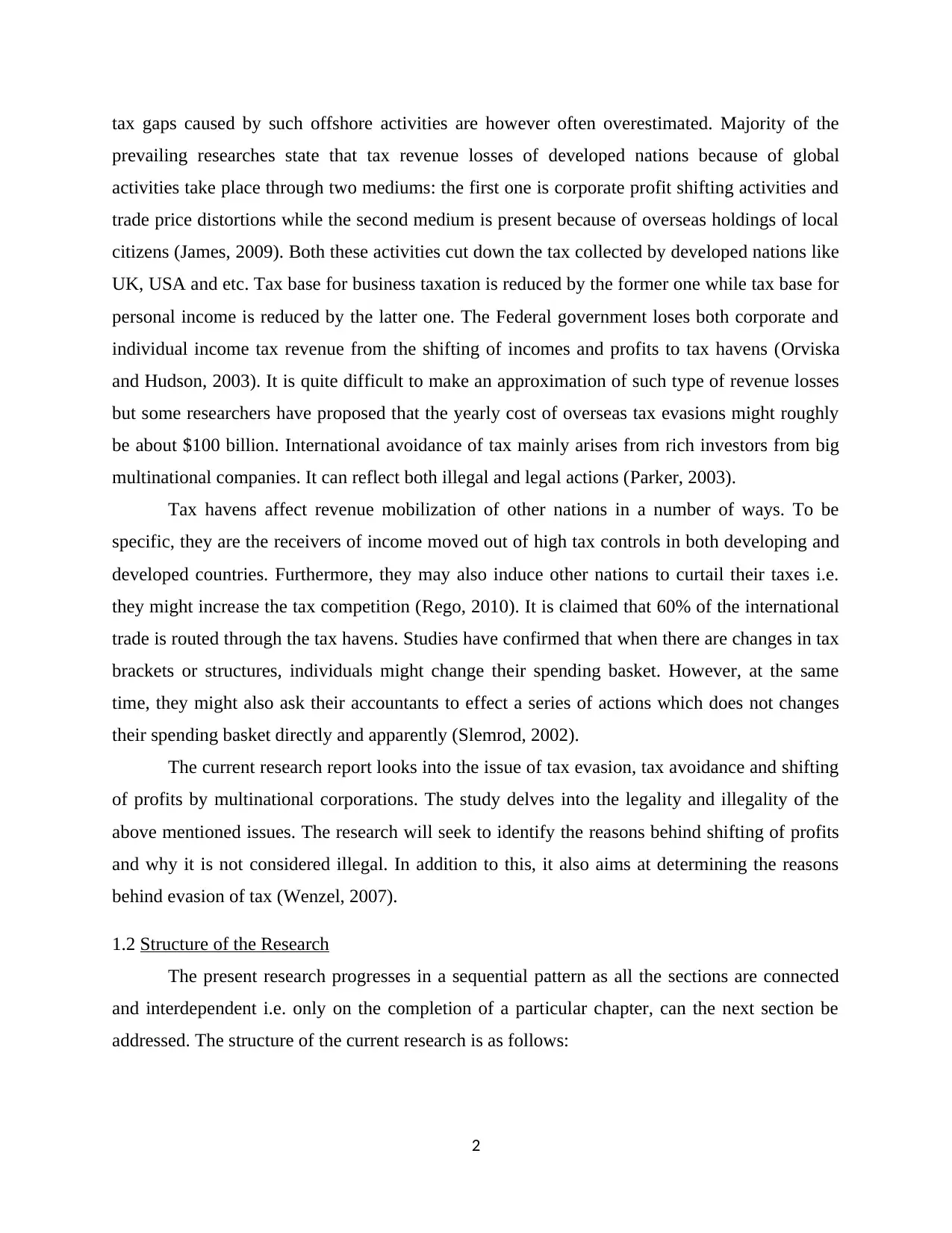
tax gaps caused by such offshore activities are however often overestimated. Majority of the
prevailing researches state that tax revenue losses of developed nations because of global
activities take place through two mediums: the first one is corporate profit shifting activities and
trade price distortions while the second medium is present because of overseas holdings of local
citizens (James, 2009). Both these activities cut down the tax collected by developed nations like
UK, USA and etc. Tax base for business taxation is reduced by the former one while tax base for
personal income is reduced by the latter one. The Federal government loses both corporate and
individual income tax revenue from the shifting of incomes and profits to tax havens (Orviska
and Hudson, 2003). It is quite difficult to make an approximation of such type of revenue losses
but some researchers have proposed that the yearly cost of overseas tax evasions might roughly
be about $100 billion. International avoidance of tax mainly arises from rich investors from big
multinational companies. It can reflect both illegal and legal actions (Parker, 2003).
Tax havens affect revenue mobilization of other nations in a number of ways. To be
specific, they are the receivers of income moved out of high tax controls in both developing and
developed countries. Furthermore, they may also induce other nations to curtail their taxes i.e.
they might increase the tax competition (Rego, 2010). It is claimed that 60% of the international
trade is routed through the tax havens. Studies have confirmed that when there are changes in tax
brackets or structures, individuals might change their spending basket. However, at the same
time, they might also ask their accountants to effect a series of actions which does not changes
their spending basket directly and apparently (Slemrod, 2002).
The current research report looks into the issue of tax evasion, tax avoidance and shifting
of profits by multinational corporations. The study delves into the legality and illegality of the
above mentioned issues. The research will seek to identify the reasons behind shifting of profits
and why it is not considered illegal. In addition to this, it also aims at determining the reasons
behind evasion of tax (Wenzel, 2007).
1.2 Structure of the Research
The present research progresses in a sequential pattern as all the sections are connected
and interdependent i.e. only on the completion of a particular chapter, can the next section be
addressed. The structure of the current research is as follows:
2
prevailing researches state that tax revenue losses of developed nations because of global
activities take place through two mediums: the first one is corporate profit shifting activities and
trade price distortions while the second medium is present because of overseas holdings of local
citizens (James, 2009). Both these activities cut down the tax collected by developed nations like
UK, USA and etc. Tax base for business taxation is reduced by the former one while tax base for
personal income is reduced by the latter one. The Federal government loses both corporate and
individual income tax revenue from the shifting of incomes and profits to tax havens (Orviska
and Hudson, 2003). It is quite difficult to make an approximation of such type of revenue losses
but some researchers have proposed that the yearly cost of overseas tax evasions might roughly
be about $100 billion. International avoidance of tax mainly arises from rich investors from big
multinational companies. It can reflect both illegal and legal actions (Parker, 2003).
Tax havens affect revenue mobilization of other nations in a number of ways. To be
specific, they are the receivers of income moved out of high tax controls in both developing and
developed countries. Furthermore, they may also induce other nations to curtail their taxes i.e.
they might increase the tax competition (Rego, 2010). It is claimed that 60% of the international
trade is routed through the tax havens. Studies have confirmed that when there are changes in tax
brackets or structures, individuals might change their spending basket. However, at the same
time, they might also ask their accountants to effect a series of actions which does not changes
their spending basket directly and apparently (Slemrod, 2002).
The current research report looks into the issue of tax evasion, tax avoidance and shifting
of profits by multinational corporations. The study delves into the legality and illegality of the
above mentioned issues. The research will seek to identify the reasons behind shifting of profits
and why it is not considered illegal. In addition to this, it also aims at determining the reasons
behind evasion of tax (Wenzel, 2007).
1.2 Structure of the Research
The present research progresses in a sequential pattern as all the sections are connected
and interdependent i.e. only on the completion of a particular chapter, can the next section be
addressed. The structure of the current research is as follows:
2
Paraphrase This Document
Need a fresh take? Get an instant paraphrase of this document with our AI Paraphraser
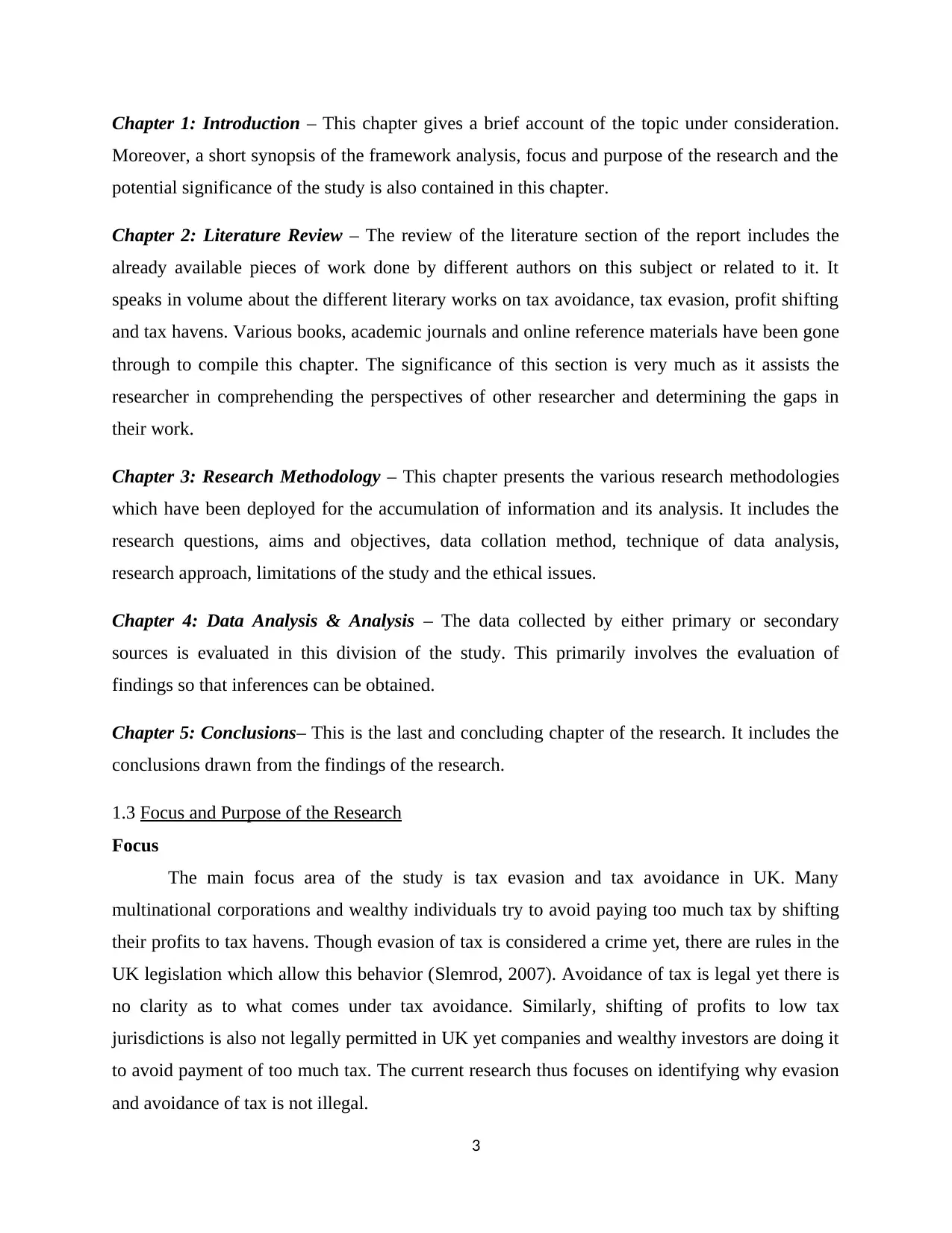
Chapter 1: Introduction – This chapter gives a brief account of the topic under consideration.
Moreover, a short synopsis of the framework analysis, focus and purpose of the research and the
potential significance of the study is also contained in this chapter.
Chapter 2: Literature Review – The review of the literature section of the report includes the
already available pieces of work done by different authors on this subject or related to it. It
speaks in volume about the different literary works on tax avoidance, tax evasion, profit shifting
and tax havens. Various books, academic journals and online reference materials have been gone
through to compile this chapter. The significance of this section is very much as it assists the
researcher in comprehending the perspectives of other researcher and determining the gaps in
their work.
Chapter 3: Research Methodology – This chapter presents the various research methodologies
which have been deployed for the accumulation of information and its analysis. It includes the
research questions, aims and objectives, data collation method, technique of data analysis,
research approach, limitations of the study and the ethical issues.
Chapter 4: Data Analysis & Analysis – The data collected by either primary or secondary
sources is evaluated in this division of the study. This primarily involves the evaluation of
findings so that inferences can be obtained.
Chapter 5: Conclusions– This is the last and concluding chapter of the research. It includes the
conclusions drawn from the findings of the research.
1.3 Focus and Purpose of the Research
Focus
The main focus area of the study is tax evasion and tax avoidance in UK. Many
multinational corporations and wealthy individuals try to avoid paying too much tax by shifting
their profits to tax havens. Though evasion of tax is considered a crime yet, there are rules in the
UK legislation which allow this behavior (Slemrod, 2007). Avoidance of tax is legal yet there is
no clarity as to what comes under tax avoidance. Similarly, shifting of profits to low tax
jurisdictions is also not legally permitted in UK yet companies and wealthy investors are doing it
to avoid payment of too much tax. The current research thus focuses on identifying why evasion
and avoidance of tax is not illegal.
3
Moreover, a short synopsis of the framework analysis, focus and purpose of the research and the
potential significance of the study is also contained in this chapter.
Chapter 2: Literature Review – The review of the literature section of the report includes the
already available pieces of work done by different authors on this subject or related to it. It
speaks in volume about the different literary works on tax avoidance, tax evasion, profit shifting
and tax havens. Various books, academic journals and online reference materials have been gone
through to compile this chapter. The significance of this section is very much as it assists the
researcher in comprehending the perspectives of other researcher and determining the gaps in
their work.
Chapter 3: Research Methodology – This chapter presents the various research methodologies
which have been deployed for the accumulation of information and its analysis. It includes the
research questions, aims and objectives, data collation method, technique of data analysis,
research approach, limitations of the study and the ethical issues.
Chapter 4: Data Analysis & Analysis – The data collected by either primary or secondary
sources is evaluated in this division of the study. This primarily involves the evaluation of
findings so that inferences can be obtained.
Chapter 5: Conclusions– This is the last and concluding chapter of the research. It includes the
conclusions drawn from the findings of the research.
1.3 Focus and Purpose of the Research
Focus
The main focus area of the study is tax evasion and tax avoidance in UK. Many
multinational corporations and wealthy individuals try to avoid paying too much tax by shifting
their profits to tax havens. Though evasion of tax is considered a crime yet, there are rules in the
UK legislation which allow this behavior (Slemrod, 2007). Avoidance of tax is legal yet there is
no clarity as to what comes under tax avoidance. Similarly, shifting of profits to low tax
jurisdictions is also not legally permitted in UK yet companies and wealthy investors are doing it
to avoid payment of too much tax. The current research thus focuses on identifying why evasion
and avoidance of tax is not illegal.
3
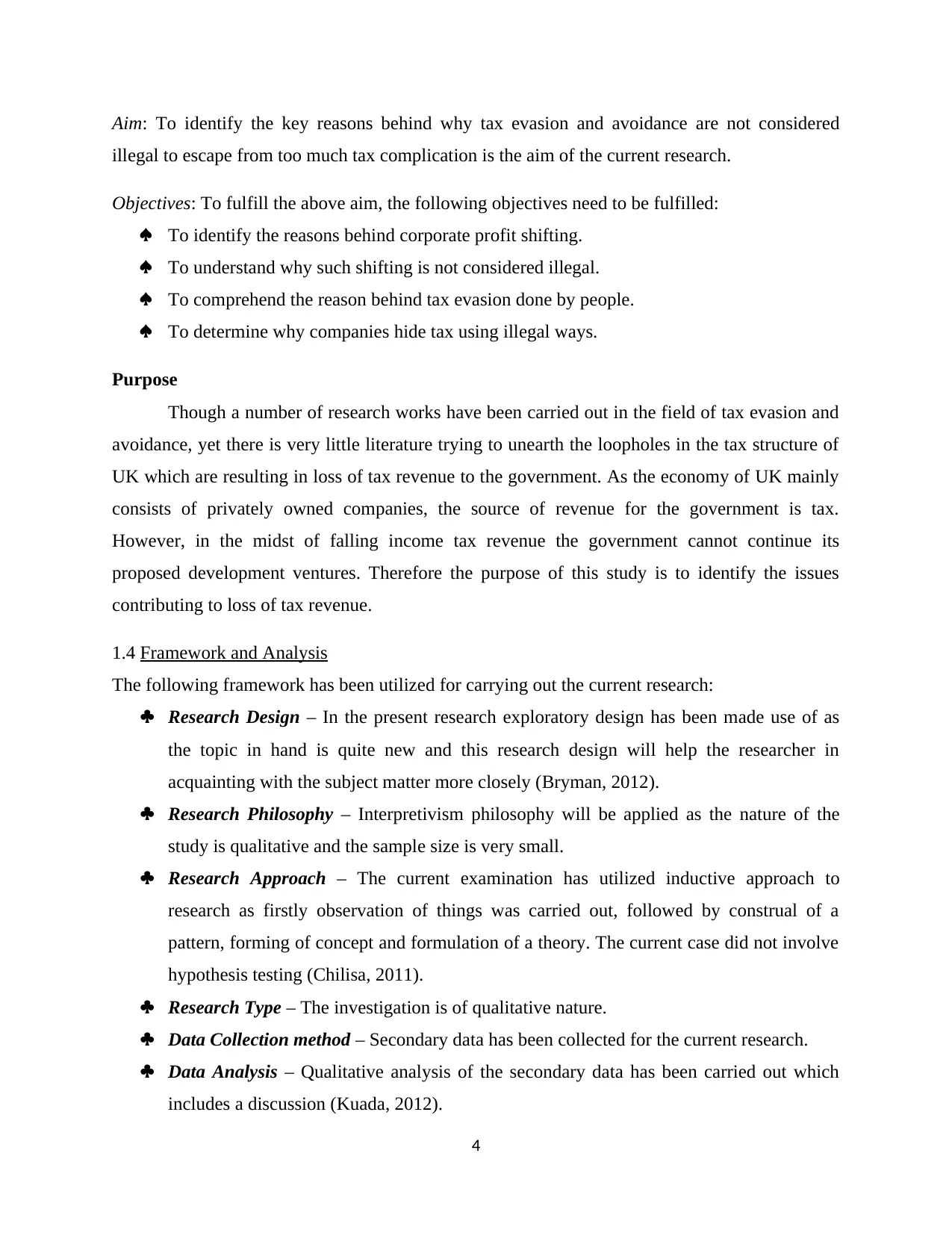
Aim: To identify the key reasons behind why tax evasion and avoidance are not considered
illegal to escape from too much tax complication is the aim of the current research.
Objectives: To fulfill the above aim, the following objectives need to be fulfilled:
To identify the reasons behind corporate profit shifting.
To understand why such shifting is not considered illegal.
To comprehend the reason behind tax evasion done by people.
To determine why companies hide tax using illegal ways.
Purpose
Though a number of research works have been carried out in the field of tax evasion and
avoidance, yet there is very little literature trying to unearth the loopholes in the tax structure of
UK which are resulting in loss of tax revenue to the government. As the economy of UK mainly
consists of privately owned companies, the source of revenue for the government is tax.
However, in the midst of falling income tax revenue the government cannot continue its
proposed development ventures. Therefore the purpose of this study is to identify the issues
contributing to loss of tax revenue.
1.4 Framework and Analysis
The following framework has been utilized for carrying out the current research:
Research Design – In the present research exploratory design has been made use of as
the topic in hand is quite new and this research design will help the researcher in
acquainting with the subject matter more closely (Bryman, 2012).
Research Philosophy – Interpretivism philosophy will be applied as the nature of the
study is qualitative and the sample size is very small.
Research Approach – The current examination has utilized inductive approach to
research as firstly observation of things was carried out, followed by construal of a
pattern, forming of concept and formulation of a theory. The current case did not involve
hypothesis testing (Chilisa, 2011).
Research Type – The investigation is of qualitative nature.
Data Collection method – Secondary data has been collected for the current research.
Data Analysis – Qualitative analysis of the secondary data has been carried out which
includes a discussion (Kuada, 2012).
4
illegal to escape from too much tax complication is the aim of the current research.
Objectives: To fulfill the above aim, the following objectives need to be fulfilled:
To identify the reasons behind corporate profit shifting.
To understand why such shifting is not considered illegal.
To comprehend the reason behind tax evasion done by people.
To determine why companies hide tax using illegal ways.
Purpose
Though a number of research works have been carried out in the field of tax evasion and
avoidance, yet there is very little literature trying to unearth the loopholes in the tax structure of
UK which are resulting in loss of tax revenue to the government. As the economy of UK mainly
consists of privately owned companies, the source of revenue for the government is tax.
However, in the midst of falling income tax revenue the government cannot continue its
proposed development ventures. Therefore the purpose of this study is to identify the issues
contributing to loss of tax revenue.
1.4 Framework and Analysis
The following framework has been utilized for carrying out the current research:
Research Design – In the present research exploratory design has been made use of as
the topic in hand is quite new and this research design will help the researcher in
acquainting with the subject matter more closely (Bryman, 2012).
Research Philosophy – Interpretivism philosophy will be applied as the nature of the
study is qualitative and the sample size is very small.
Research Approach – The current examination has utilized inductive approach to
research as firstly observation of things was carried out, followed by construal of a
pattern, forming of concept and formulation of a theory. The current case did not involve
hypothesis testing (Chilisa, 2011).
Research Type – The investigation is of qualitative nature.
Data Collection method – Secondary data has been collected for the current research.
Data Analysis – Qualitative analysis of the secondary data has been carried out which
includes a discussion (Kuada, 2012).
4
⊘ This is a preview!⊘
Do you want full access?
Subscribe today to unlock all pages.

Trusted by 1+ million students worldwide
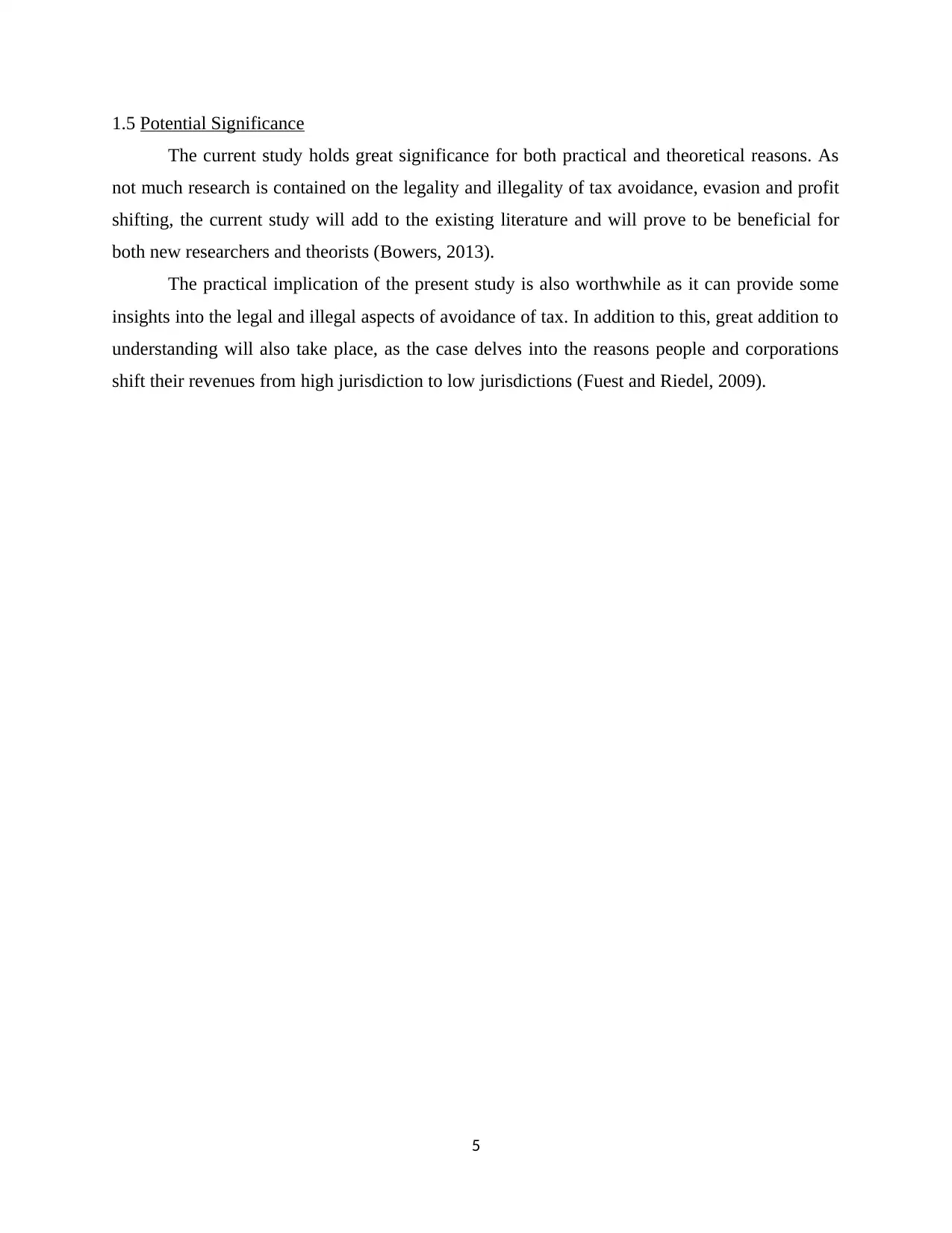
1.5 Potential Significance
The current study holds great significance for both practical and theoretical reasons. As
not much research is contained on the legality and illegality of tax avoidance, evasion and profit
shifting, the current study will add to the existing literature and will prove to be beneficial for
both new researchers and theorists (Bowers, 2013).
The practical implication of the present study is also worthwhile as it can provide some
insights into the legal and illegal aspects of avoidance of tax. In addition to this, great addition to
understanding will also take place, as the case delves into the reasons people and corporations
shift their revenues from high jurisdiction to low jurisdictions (Fuest and Riedel, 2009).
5
The current study holds great significance for both practical and theoretical reasons. As
not much research is contained on the legality and illegality of tax avoidance, evasion and profit
shifting, the current study will add to the existing literature and will prove to be beneficial for
both new researchers and theorists (Bowers, 2013).
The practical implication of the present study is also worthwhile as it can provide some
insights into the legal and illegal aspects of avoidance of tax. In addition to this, great addition to
understanding will also take place, as the case delves into the reasons people and corporations
shift their revenues from high jurisdiction to low jurisdictions (Fuest and Riedel, 2009).
5
Paraphrase This Document
Need a fresh take? Get an instant paraphrase of this document with our AI Paraphraser
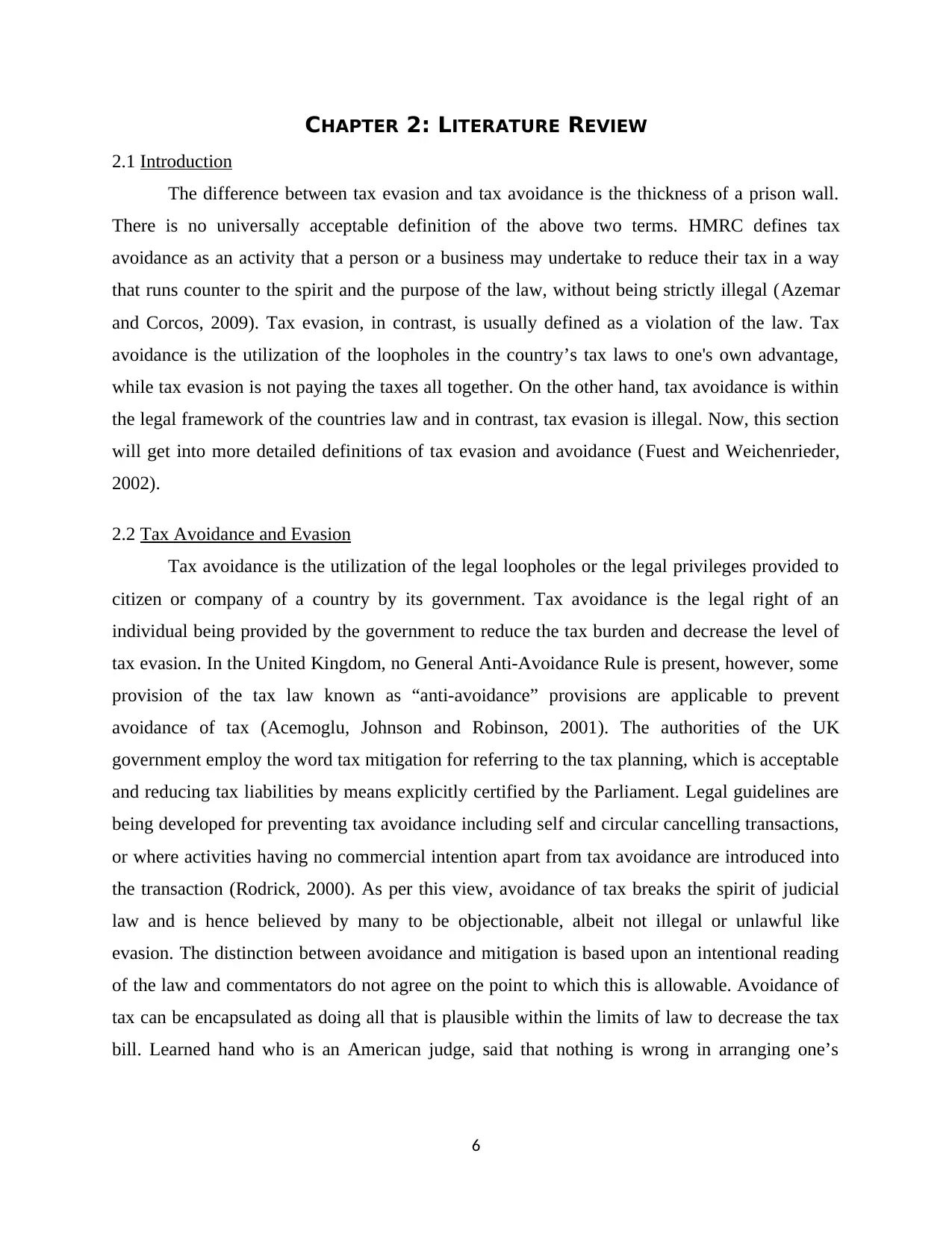
CHAPTER 2: LITERATURE REVIEW
2.1 Introduction
The difference between tax evasion and tax avoidance is the thickness of a prison wall.
There is no universally acceptable definition of the above two terms. HMRC defines tax
avoidance as an activity that a person or a business may undertake to reduce their tax in a way
that runs counter to the spirit and the purpose of the law, without being strictly illegal (Azemar
and Corcos, 2009). Tax evasion, in contrast, is usually defined as a violation of the law. Tax
avoidance is the utilization of the loopholes in the country’s tax laws to one's own advantage,
while tax evasion is not paying the taxes all together. On the other hand, tax avoidance is within
the legal framework of the countries law and in contrast, tax evasion is illegal. Now, this section
will get into more detailed definitions of tax evasion and avoidance (Fuest and Weichenrieder,
2002).
2.2 Tax Avoidance and Evasion
Tax avoidance is the utilization of the legal loopholes or the legal privileges provided to
citizen or company of a country by its government. Tax avoidance is the legal right of an
individual being provided by the government to reduce the tax burden and decrease the level of
tax evasion. In the United Kingdom, no General Anti-Avoidance Rule is present, however, some
provision of the tax law known as “anti-avoidance” provisions are applicable to prevent
avoidance of tax (Acemoglu, Johnson and Robinson, 2001). The authorities of the UK
government employ the word tax mitigation for referring to the tax planning, which is acceptable
and reducing tax liabilities by means explicitly certified by the Parliament. Legal guidelines are
being developed for preventing tax avoidance including self and circular cancelling transactions,
or where activities having no commercial intention apart from tax avoidance are introduced into
the transaction (Rodrick, 2000). As per this view, avoidance of tax breaks the spirit of judicial
law and is hence believed by many to be objectionable, albeit not illegal or unlawful like
evasion. The distinction between avoidance and mitigation is based upon an intentional reading
of the law and commentators do not agree on the point to which this is allowable. Avoidance of
tax can be encapsulated as doing all that is plausible within the limits of law to decrease the tax
bill. Learned hand who is an American judge, said that nothing is wrong in arranging one’s
6
2.1 Introduction
The difference between tax evasion and tax avoidance is the thickness of a prison wall.
There is no universally acceptable definition of the above two terms. HMRC defines tax
avoidance as an activity that a person or a business may undertake to reduce their tax in a way
that runs counter to the spirit and the purpose of the law, without being strictly illegal (Azemar
and Corcos, 2009). Tax evasion, in contrast, is usually defined as a violation of the law. Tax
avoidance is the utilization of the loopholes in the country’s tax laws to one's own advantage,
while tax evasion is not paying the taxes all together. On the other hand, tax avoidance is within
the legal framework of the countries law and in contrast, tax evasion is illegal. Now, this section
will get into more detailed definitions of tax evasion and avoidance (Fuest and Weichenrieder,
2002).
2.2 Tax Avoidance and Evasion
Tax avoidance is the utilization of the legal loopholes or the legal privileges provided to
citizen or company of a country by its government. Tax avoidance is the legal right of an
individual being provided by the government to reduce the tax burden and decrease the level of
tax evasion. In the United Kingdom, no General Anti-Avoidance Rule is present, however, some
provision of the tax law known as “anti-avoidance” provisions are applicable to prevent
avoidance of tax (Acemoglu, Johnson and Robinson, 2001). The authorities of the UK
government employ the word tax mitigation for referring to the tax planning, which is acceptable
and reducing tax liabilities by means explicitly certified by the Parliament. Legal guidelines are
being developed for preventing tax avoidance including self and circular cancelling transactions,
or where activities having no commercial intention apart from tax avoidance are introduced into
the transaction (Rodrick, 2000). As per this view, avoidance of tax breaks the spirit of judicial
law and is hence believed by many to be objectionable, albeit not illegal or unlawful like
evasion. The distinction between avoidance and mitigation is based upon an intentional reading
of the law and commentators do not agree on the point to which this is allowable. Avoidance of
tax can be encapsulated as doing all that is plausible within the limits of law to decrease the tax
bill. Learned hand who is an American judge, said that nothing is wrong in arranging one’s
6
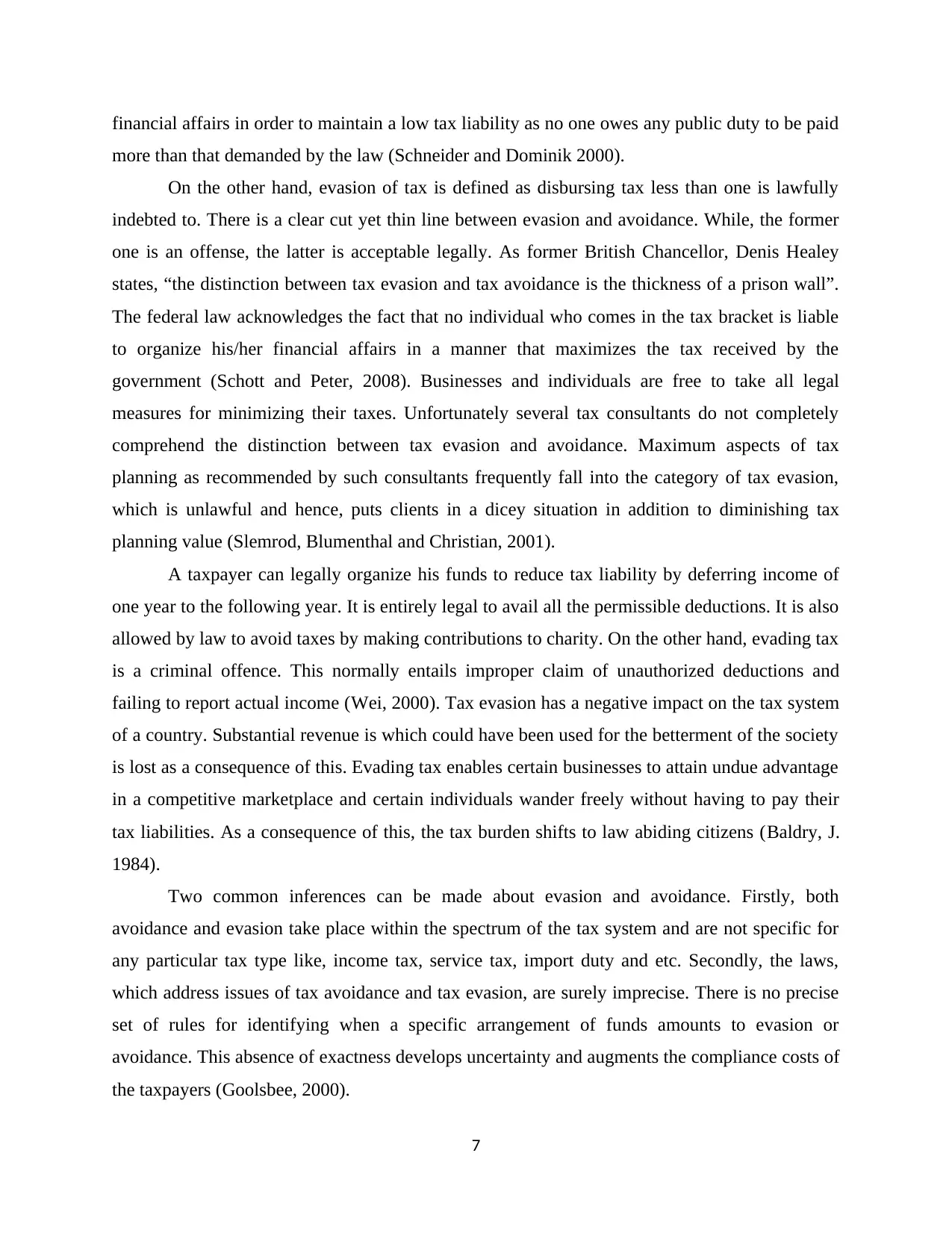
financial affairs in order to maintain a low tax liability as no one owes any public duty to be paid
more than that demanded by the law (Schneider and Dominik 2000).
On the other hand, evasion of tax is defined as disbursing tax less than one is lawfully
indebted to. There is a clear cut yet thin line between evasion and avoidance. While, the former
one is an offense, the latter is acceptable legally. As former British Chancellor, Denis Healey
states, “the distinction between tax evasion and tax avoidance is the thickness of a prison wall”.
The federal law acknowledges the fact that no individual who comes in the tax bracket is liable
to organize his/her financial affairs in a manner that maximizes the tax received by the
government (Schott and Peter, 2008). Businesses and individuals are free to take all legal
measures for minimizing their taxes. Unfortunately several tax consultants do not completely
comprehend the distinction between tax evasion and avoidance. Maximum aspects of tax
planning as recommended by such consultants frequently fall into the category of tax evasion,
which is unlawful and hence, puts clients in a dicey situation in addition to diminishing tax
planning value (Slemrod, Blumenthal and Christian, 2001).
A taxpayer can legally organize his funds to reduce tax liability by deferring income of
one year to the following year. It is entirely legal to avail all the permissible deductions. It is also
allowed by law to avoid taxes by making contributions to charity. On the other hand, evading tax
is a criminal offence. This normally entails improper claim of unauthorized deductions and
failing to report actual income (Wei, 2000). Tax evasion has a negative impact on the tax system
of a country. Substantial revenue is which could have been used for the betterment of the society
is lost as a consequence of this. Evading tax enables certain businesses to attain undue advantage
in a competitive marketplace and certain individuals wander freely without having to pay their
tax liabilities. As a consequence of this, the tax burden shifts to law abiding citizens (Baldry, J.
1984).
Two common inferences can be made about evasion and avoidance. Firstly, both
avoidance and evasion take place within the spectrum of the tax system and are not specific for
any particular tax type like, income tax, service tax, import duty and etc. Secondly, the laws,
which address issues of tax avoidance and tax evasion, are surely imprecise. There is no precise
set of rules for identifying when a specific arrangement of funds amounts to evasion or
avoidance. This absence of exactness develops uncertainty and augments the compliance costs of
the taxpayers (Goolsbee, 2000).
7
more than that demanded by the law (Schneider and Dominik 2000).
On the other hand, evasion of tax is defined as disbursing tax less than one is lawfully
indebted to. There is a clear cut yet thin line between evasion and avoidance. While, the former
one is an offense, the latter is acceptable legally. As former British Chancellor, Denis Healey
states, “the distinction between tax evasion and tax avoidance is the thickness of a prison wall”.
The federal law acknowledges the fact that no individual who comes in the tax bracket is liable
to organize his/her financial affairs in a manner that maximizes the tax received by the
government (Schott and Peter, 2008). Businesses and individuals are free to take all legal
measures for minimizing their taxes. Unfortunately several tax consultants do not completely
comprehend the distinction between tax evasion and avoidance. Maximum aspects of tax
planning as recommended by such consultants frequently fall into the category of tax evasion,
which is unlawful and hence, puts clients in a dicey situation in addition to diminishing tax
planning value (Slemrod, Blumenthal and Christian, 2001).
A taxpayer can legally organize his funds to reduce tax liability by deferring income of
one year to the following year. It is entirely legal to avail all the permissible deductions. It is also
allowed by law to avoid taxes by making contributions to charity. On the other hand, evading tax
is a criminal offence. This normally entails improper claim of unauthorized deductions and
failing to report actual income (Wei, 2000). Tax evasion has a negative impact on the tax system
of a country. Substantial revenue is which could have been used for the betterment of the society
is lost as a consequence of this. Evading tax enables certain businesses to attain undue advantage
in a competitive marketplace and certain individuals wander freely without having to pay their
tax liabilities. As a consequence of this, the tax burden shifts to law abiding citizens (Baldry, J.
1984).
Two common inferences can be made about evasion and avoidance. Firstly, both
avoidance and evasion take place within the spectrum of the tax system and are not specific for
any particular tax type like, income tax, service tax, import duty and etc. Secondly, the laws,
which address issues of tax avoidance and tax evasion, are surely imprecise. There is no precise
set of rules for identifying when a specific arrangement of funds amounts to evasion or
avoidance. This absence of exactness develops uncertainty and augments the compliance costs of
the taxpayers (Goolsbee, 2000).
7
⊘ This is a preview!⊘
Do you want full access?
Subscribe today to unlock all pages.

Trusted by 1+ million students worldwide
1 out of 32
Related Documents
Your All-in-One AI-Powered Toolkit for Academic Success.
+13062052269
info@desklib.com
Available 24*7 on WhatsApp / Email
![[object Object]](/_next/static/media/star-bottom.7253800d.svg)
Unlock your academic potential
Copyright © 2020–2025 A2Z Services. All Rights Reserved. Developed and managed by ZUCOL.





